Laptop Mag Verdict
The ASUS MeMO Pad HD 7 combines a gorgeous screen, epic battery life, strong performance and a slew of premium features for under $150
Pros
- +
Gorgeous IPS display with wide viewing angles
- +
Strong battery life
- +
Good camera with lots of features
- +
Accurate sound
- +
Helpful ASUS software and widgets
Cons
- -
Awkward power and volume button placement
- -
Picks up fingerprints
- -
Custom UI occasionally a little laggy
Why you can trust Laptop Mag
Not long ago, you couldn't find a decent Android tablet for under $400. Today, you can find powerful 7-inchers like the Google Nexus 7 and Kindle Fire HD selling for around $199 with off-brand upstarts like the HiSense Sero 7 Pro selling for around $150 to $160. Enter the ASUS MeMO Pad HD 7, a $149 Android tablet that raises the bar for budget slates with a stunningly colorful 720p display, a quality rear-facing camera and microSD card expansion. With epic battery life, strong performance and powerful custom software, this is not only the leading tablet under $200, but one of the best you can purchase at any price.
[sc:video id="x5NnE1cTrx69UQ1WJn-0r30AOQlzzwVr" width="575" height="398"]
Design
The MeMO Pad HD 7's chassis is covered in plastic that sits on top of aluminum base that gives the device a solid, durable feel. Users who dislike fingerprint marks won't appreciate the tablet's reflective surfaces. But with its minimalist looks and different color options, the back panel gives the ASUS MeMO Pad HD 7 a fashion-forward design.
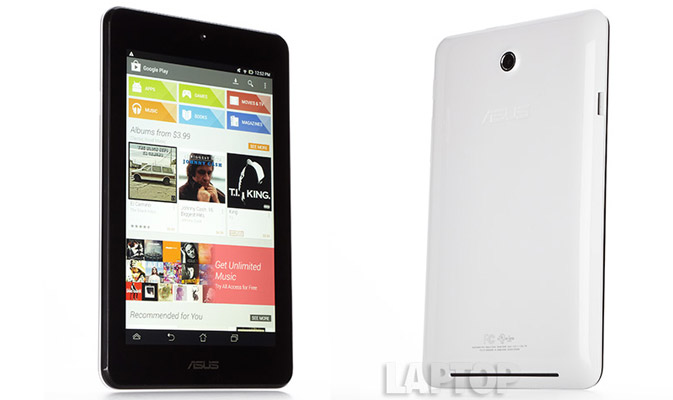
Our review unit came with a white back, but the MeMO Pad HD 7 is also available in Midnight Blue, Vivid Pink, Lime Green and Charcoal Gray. We highly recommend the blue, pink or green colors, because they really look impressive. We wish, however, that the bezel wasn't so thick and that the power button and volume rocker weren't angled toward the back.
MORE:Tablet Buyers' Guide: 5 Questions to Ask Before You Buy
At 7.7 x 4.7 x 0.4 inches and 11 ounces, the MeMO Pad HD 7 is noticeably lighter and shorter than the HiSense Sero 7 Pro (7.9 x 5 x 0.4 inches, 12.7 ounces) and just a bit lighter than the Google Nexus 7 (7.8 x 4.7 x 0.41, 12 ounces) and 8-inch Samsung Galaxy Note 8 (8.3 x 5.35 x 0.31, 12 ounces). The Amazon Kindle Fire HD (7.6 x 5.4 x 0.4 inches, 13.9 ounces) is significantly bulkier.
Ports
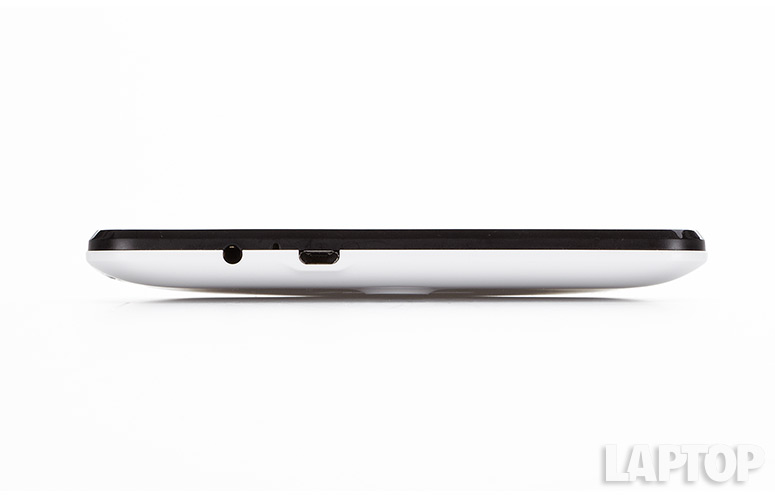
Click to EnlargeThe ASUS MeMO Pad HD 7 has a couple of helpful connections you won't find on all of its competitors. Like the Nexus 7, but unlike the iPad mini and many other small tablets, the HD 7 charges via a standard microUSB port, which means you should be able to use most standard cables to charge it. Unlike the Kindle Fire HD and Nexus 7, ASUS' tablet has a microSD card slot for memory expansion. Considering that a 32GB microSD card costs under $25 and the MeMO Pad HD 7 comes with 16GB of internal Flash, users are able to get a lot of additional storage for not much money.
The HiSense Sero 7 Pro also has a microSD card slot, but throws in a mini HDMI out port for connecting to your TV. While the MeMO Pad HD 7 doesn't have a wired connection for your TV, it does support the Miracast wireless display standard.
Display
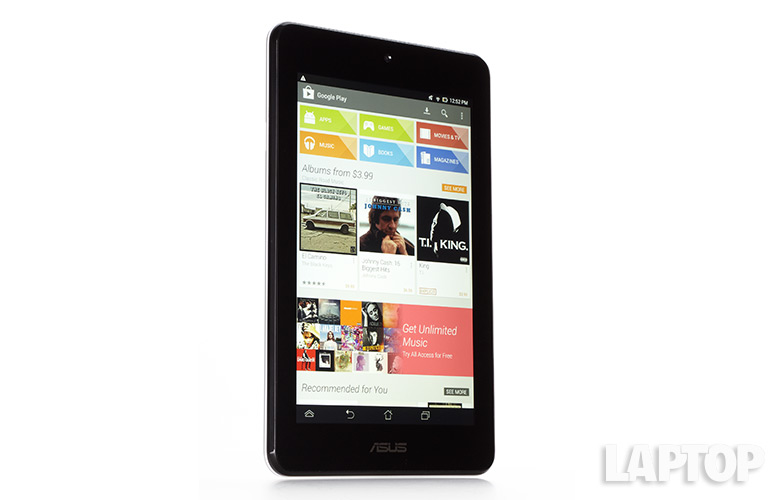
Click to EnlargeThe ASUS MeMO Pad HD 7's 1280 x 800 IPS display is one of the sharpest and most vibrant we've seen on a tablet this size. When we played offline 1080p trailers for "Skyfall" and "Riddick," fine details like stubble in a character's face were easily visible while colors like the green in some trees really popped. Viewing angles were strong as colors did not fade at 90 degree angles to the left or right.
Better still, the MeMO Pad HD 7 includes a unique screen-tuning utility called ASUS Splendid that allows you to adjust the color temperature, hue and saturation while toggling Vibrant Mode. We particularly enjoyed moving the different slider bars in Splendid and seeing their effects on a preview image or raspberries. Enabling Vibrant Mode made colors in the trailers look noticeably more vivid.
At full brightness, the MemoPad HD 7 measured 358 lux on our light meter, which is well ahead of the Nexus 7 (314), about on par with the 355 lux tablet category average. The ASUS is slightly lower than the HiSense Sero 7 Pro (369) and way below the Amazon Kindle Fire HD (436). Though the screen looks bright and color indoors and in a shady area, it was harder to read in direct sunlight.
Audio
The rear-facing speaker bar on the MeMO Pad HD 7, which features ASUS SonicMaster technology, produced accurate audio that was loud enough to fill a small living room. When we listened to the bass-heavy R&B "Forget Me Nots," sound was rich and layered. The heavy metal "She's Got the Looks That Kill" wasn't as textured, but wasn't tinny either. ASUS's AudioWizard software allowed us to switch between different sound profiles, such as Gaming, Speed, Movie or Music Mode. As you might expect, songs sounded best in Music Mode.
Keyboard
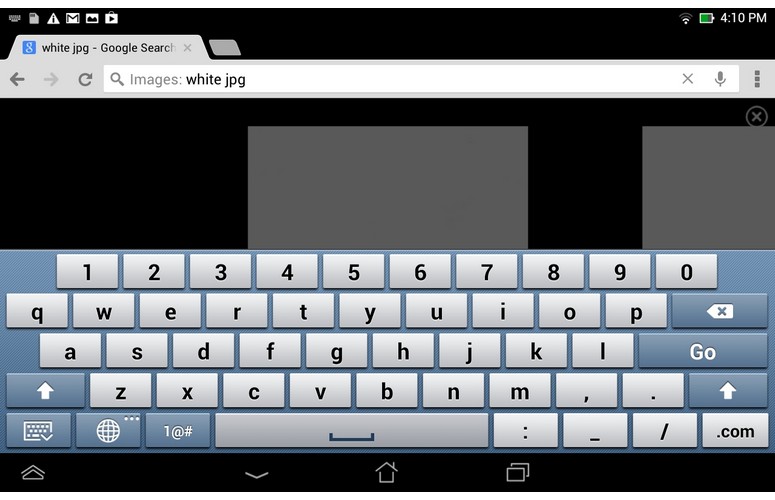
Click to EnlargeThe ASUS MeMO Pad HD 7 comes with both the stock Android 4.2 keyboard and its own ASUS virtual keyboard, which offers a few advantages. This includes a dedicated number row, optional trace typing and an attractive light blue background behind the gray keys. The ASUS keyboard also supports next-word prediction. Unlike Swiftkey, the keyboard cannot learn from your past patterns on social networks. Neither keyboard supports haptic feedback.
Android UI
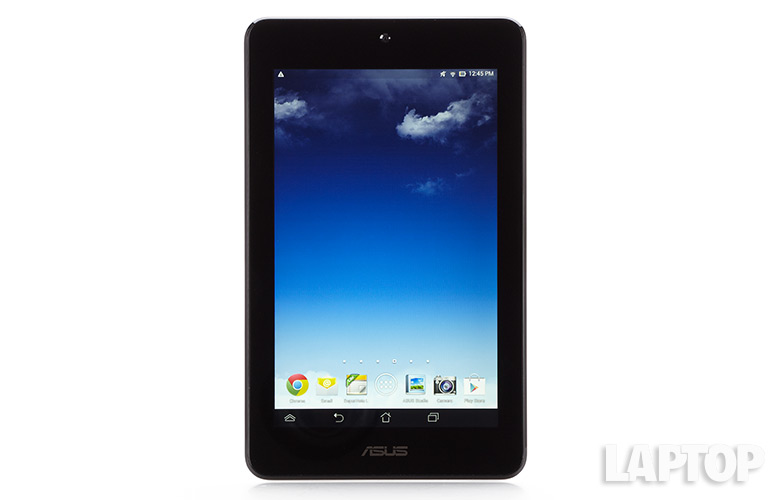
Click to EnlargeThe ASUS MeMO Pad HD 7 comes with a heavily modified version of Android 4.2.1. Though ASUS does not give its Android skin a name like Samsung does with TouchWiz or HTC with Sense, the company has made several significant changes to the stock Jelly Bean UI. The most obvious change involves the look, feel and function of the virtual navigation buttons. The home, back and task switching buttons all look slightly different than on stock Android. Long-pressing the home button brings up a circular shortcut menu with two rings. There's an inner ring with shortcuts to Google Search, the apps menu, voice search, a settings icon and system bar lock, which lets you disable all the buttons on the bar to avoid accidentally hitting them while doing something important like playing a game. The outer ring contains a customizable set of shortcuts to your favorite apps you can add or remove from when you tap that settings button. By default, these shortcuts included the calendar, browser and calculator apps, among others.
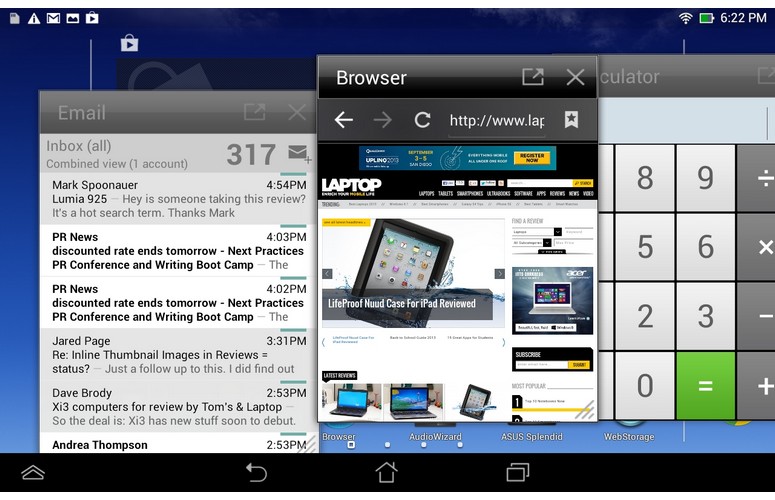
Click to EnlargeASUS has also added a fourth navigation button that sits on the left side of the system bar and launches a horizontal shortcut menu with shortcuts that specifically launch floating apps. These floating apps, which include the browser, email, calendar, calculator, video player and currency converter, launch in their own draggable windows that appear on top of your work. You can open as many of these windows as you like and add any widget, even third-party options, to the floating apps list. We particularly enjoyed reading our email in the floating email widget while looking at Laptopmag.com in a small floating browser window. We were pleased to see that, after installing Rhapsody, we were able to use Rhapsody's player widget as a floating app.
Where most Android devices have several desktops and a few let you add or remove desktops at will, the MeMO Pad HD 7 takes desktop customization to another level. If you pinch-zoom out on the current desktop, you're shown thumbnails not only of your different desktops, but of different "modes" that each contain their own sets of desktops with different shortcuts, widgets and wallpaper. By default, the tablet has modes for ASUS (the default set of five desktops), Work (which has to-do list and calendar icons prominently displayed), Entertainment (YouTube widget) and the option to add other modes. We're not sure why a user would need so many different desktops and to divide them up into modes, but it's great to have so much flexibility.
Like Samsung, LG and HTC, ASUS has its own custom notification drawer, which has a row of quick setting toggles for Wi-Fi, Bluetooth, Silent Mode, Auto sync, and Auto rotate. Below that sit a brightness slider and shortcuts for the Wi-Fi network chooser, audio manager, settings menu and wireless display menu in addition to all your current notifications.
Like other heavy Android skins, ASUS's custom UI can be a bit laggy at times. In our tests, we sometimes noticed small, but annoying delays when switching apps or returning to the home screen.
Preloaded apps
ASUS bundles the MeMO Pad HD 7 with a slew of very useful and attractive proprietary apps. ASUS To-Do list helps you organize your tasks. SuperNote Lite is great for taking notes, organizing them and syncing them with the cloud. App Locker allows you to password-protect certain apps, restricting family members for accessing things they shouldn't.
MORE: 25 Best Android Apps
We particularly like the suite of custom image-editing/creation tools ASUS includes. ASUS Studio is a full-featured photo editor that lets you apply filters to your photos, crop them, draw on them, frame them or even write text on top of them. We really enjoyed using ASUS Artist, a detailed drawing program that allowed us to sketch with several different kinds of brushes, including a spray paint can, a pen and a traditional paintbrush. ASUS Story let us create a digital photo album from some of our snapshots.
ASUS also provides 16GB of free cloud storage for a year so users can keep plenty of their data in the cloud.
Performance
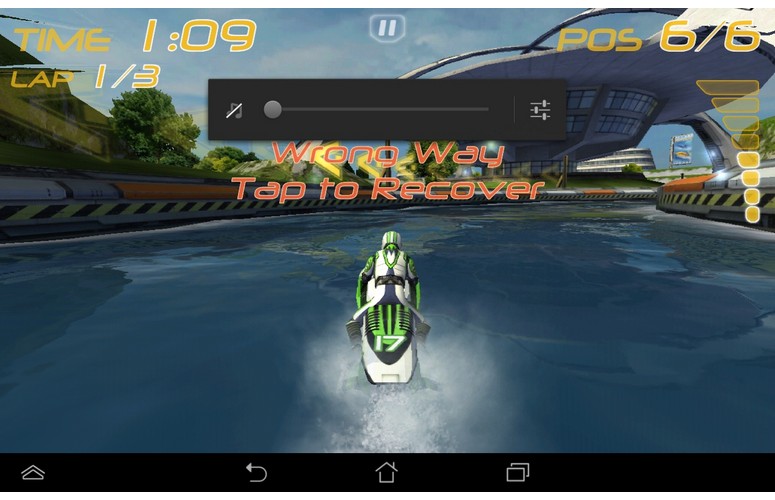
Click to EnlargeRather than using a processor from well-known vendors like Nvidia, Qualcomm or Samsung, the ASUS MeMO Pad HD 7 employs a 1.2-GHz quad-core MediaTek MT8125 CPU. Consumers should not be discouraged by this less well-known component, because in our tests, ASUS's tablet provided strong real-world performance. Whether we were viewing a 1080p video, stitching together a panoramic image or running a demanding game, the MT8125 was more than up to the task. As with other Android tablets, we did occasionally notice moments of lag when switching tasks or opening large apps like the ASUS Studio photo editor, but these delays were short and rare.
When we played the Jet Ski racing game "Riptide GP," we not only had smooth motion and sharp images, but also got quad-core special effects like water splashing on the camera after a jump. Shadowgun looked absolutely gorgeous on the 7-inch display with lots of billowing smoke effects and intricate backgrounds.
On Quadrant, a synthetic benchmark that measures overall performance, the ASUS MeMO Pad HD 7 scored a solid 3,414, comfortably above the 3,249 tablet category average, the Tegra 3-powered Google Nexus 7 (3,357) and the dual-core, TI OMAP 4460-powered Amazon Kindle Fire HD (2,167). However, the HiSense Sero 7 Pro and its Nvidia Tegra 3 T30 CPU scored 4,109.
When we ran An3DBench, a test that measures graphics prowess, the ASUS MeMO Pad HD 7 scored an unremarkable 7,139, a bit below the 7,320 category average, along with the scores returned by the Google Nexus 7 (7,782), HiSense Sero 7 Pro (7,636) and Amazon Kindle Fire HD (7,783).
Camera

Click to EnlargeLike the HiSense Sero 7 Pro but unlike most other competitors, the ASUS MeMO Pad HD 7 has a rear-facing 5-MP shooter in addition to its 1.2-MP front lens. In our tests, the rear camera captured colorful, sharp images in bright light, but suffered from some haze in dim lighting. When we took some photos of a city street at mid-day, objects like the façade on a building were particularly detailed while colors like the red, white and blue in a flag seemed particularly vibrant. Unfortunately, some shots we took of a different street at sunset appeared a bit noisy.
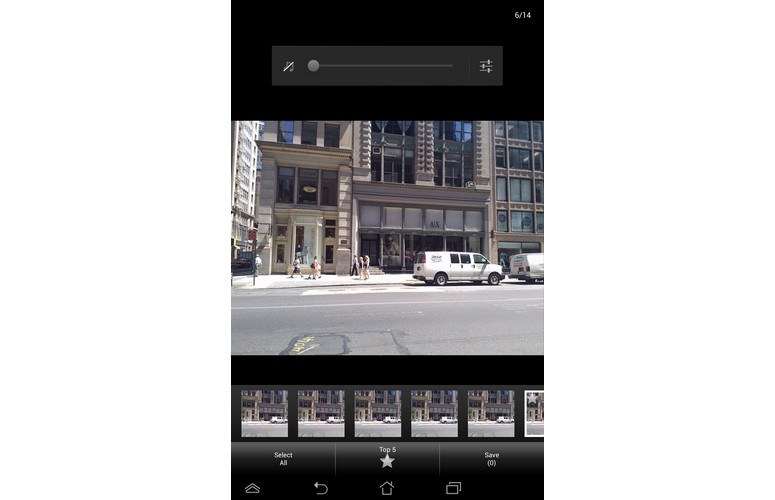
Click to EnlargeASUS's camera software has a number of helpful features, including HDR shooting, Panorama Mode and Burst Mode. We found the Burst Mode particularly useful, because it not only let us shoot a lot of images quickly, but it also allowed us to choose which ones we wanted to keep and discard after shooting was complete. To take an accurate panorama, we found that we had to rotate the tablet very slowly and deliberately. Fortunately, when we shot a panorama of our office, the on-screen progress indicator told us we were moving too quickly and allowed us to backtrack by a few inches so it could reshoot part of the frame. When we were finished, the MeMO Pad HD 7 took just a few seconds to stitch together the image and it looked completely accurate.
The rear camera can also shoot high-quality 1080p video. When we captured a full HD clip of cars rolling down a city street, the texture of the pavement and the reflections of sunlight glistening off the side of a truck looked really alive.
[sc:video id="psYjFncTosYxC9sAs9F7vpEOxDsgUwOd" width="575" height="398"]

Click to EnlargeWe had to be very careful about how we held the MeMO Pad HD 7 when shooting in Landscape Mode, because it was too easy to cover the rear camera with our fingers. Considering that most users will use the back-facing camera in Landscape Mode, we wish the rear camera was in the top middle of the back panel rather than on the right side of it.
The front-facing camera shot detailed, colorful portraits both under the fluorescent lights of our office and in sunlight. When shooting some outdoor self-portraits in direct sunlight, we did notice a little white haze around our face.
Battery life
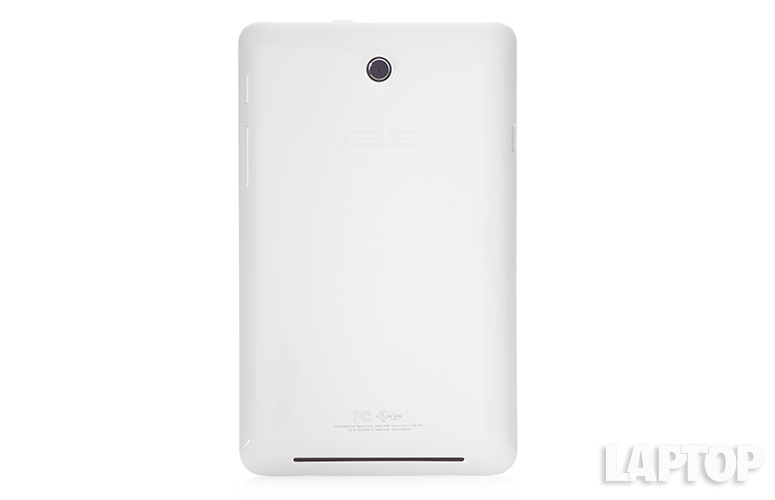
Click to EnlargeIf you're bringing the ASUS MeMO Pad HD 7 with you, you can leave your AC adapter and charging cable at home. The tablet lasted an impressive 9 hours and 40 minutes on the LAPTOP Battery Test, which involves continuous surfing over Wi-Fi. That's 2 hours and 40 minutes longer than the 7:02 tablet category average, 3.5 hours longer than the Hisense Sero 7 Pro and more than 2 longer than the Google Nexus 7. Apple's iPad mini, which costs $180 more and runs a iOS instead of Android, lasted 10 hours and 33 minutes.
MORE: 10 Tablets with the Longest Battery Life
Accessories
ASUS offers a number of covers and cases for the MeMO Pad HD 7. The $39.99 TransCover comes in blue, black, gray and pink and folds out to serve as a stand. The $19.99 Persona Cover is available in pink, lime green and dark blue and opens like a book to reveal your tablet. The VersaSleeve 7 (price TBD) folds open like a wallet, can prop the tablet up in Landscape Mode and comes in gray, pink, blue and black.
Verdict
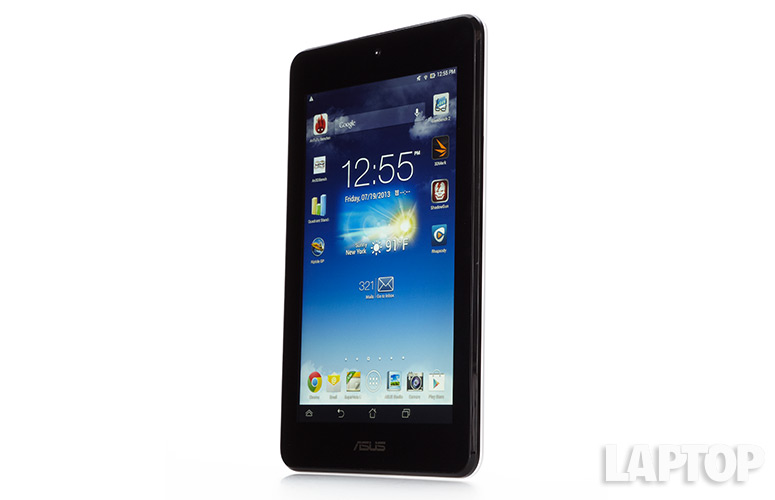
Click to EnlargeWith a gorgeous screen, strong battery life, performance that's good enough for real gaming and a ton of helpful software, the ASUS MeMO Pad HD 7 looks and feels like it should cost a lot more than its budget $149 price. While you can get the HiSense Sero 7 Pro, which has a faster processor and mini HDMI out, for the same price, ASUS's tablet has much longer battery life, weighs less and offers a slew of helpful custom software.
If you want a small tablet with stronger note-taking ability and are willing to pay a lot more, consider the $399 Samsung Galaxy Note 8. However, if you want the best combination of value, endurance and performance in a tablet today, go for the ASUS MeMO Pad HD 7.
ASUS MeMO Pad HD 7 Specs
| Brand | ASUS |
| CPU | 1.2-GHz Quad Core MediaTek MT8125 |
| Camera Resolution | 5MP |
| Card Reader Size | 32GB |
| Card Readers | microSD |
| Company Website | http://www.asus.com |
| Display Resolution | 1280 x 800 |
| Display Size | 7 |
| Front-Facing Camera Resolution | 1.2MP |
| Graphics Chip | PowerVR SGX 544 |
| Has Bluetooth | Yes |
| OS | Android 4.2 |
| Ports | Headphone, microUSB |
| RAM Included | 1GB |
| RAM Upgradeable | 1GB |
| Size | 7.7 x 4.7 x .4 inches |
| Storage Drive Size | 16GB |
| Storage Drive Type | Flash Memory |
| USB Ports | 1 |
| Weight | 11 ounces |
| Wi-Fi | 802.11b/g/n |

